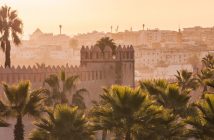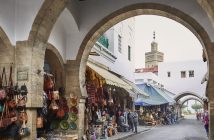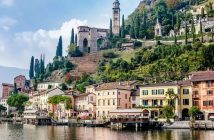In the first part of a double feature this weekend, Sophie McLean revisits Morocco’s capital and discovers a side of the city that has moved into the 21st century with vigour…
As we touch down on the runway, white diamond-like columns loom on the other side of the asphalt. The new terminal at Morocco’s RAK international airport is quite the building to behold. Albeit now two and a half years since it has been re-opened, this makes a remarkable change to the Morocco I first encountered on the very same spot eight years ago. Then we stood in hot line for well over an hour and a half waiting for our passports to be stamped in sweet anticipation of getting out into the city. Today the process is a breeze – one so speedy (on this occasion) that you almost don’t have time to look up at the clean, linear, beautiful architecture of these traditional-come-modern surrounds (they really are impressive).
Since I was last here, downtown Marrakech has seen some changes too. There are still the familiar oddities of the souks, the strange snake charmers in the red-washed Jemaa El Fna square, the tooth pullers and the cat-callers from the fresh orange juice stands. The intoxicating aromas of leather goods and spice still permeate the air in a haze of all the colours of a scented rainbow, but with it comes a noticeable step up in city life: style. The modern face of Marrakech becomes more beguiling by the minute. The developments are enrapt with a new edge of sharp design. And still the original lure prevails.

For the next few days we find our home from home at Riad Farnatchi – a boutique collection of bedrooms whose quiet, intimate ambience and personalised service makes you feel more like guests in someone’s country house than a non-specific resident in a big branded hotel. With wood-pigeon coos providing a curiously familiar underscore to a Vanity Fair printed over-score on the roof terrace’s sun loungers, the 10 luxury suites here are full of Moroccan charm, boasting cosy fireplaces, ornate mirrors and mosaic tiled balconies, some overlooking the azure-coloured plunge pool in the main building’s central courtyard.
Breakfast here happens at any time of day, on demand via a simple telephone call to the kitchen (alarm clocks truly never need to be set – a deliberate intention of the owners). The Riad also boasts the top quality Farnatchi spa where the whole Hammam experience will leave you positively breathless. Those who need to melt their muscles further should engage with a massage – the spa’s senior masseur is advertised as having ‘only one pair of hands’ and for good reason – he’s often fully booked.

On an unusually rainy Moroccan day we cross town to explore the recently opened Yves Saint Laurent museum – a splash of further sharp glamour into a city that has been hosting similarly advanced creatives and their musings for many years. A wide array of YSL’s work is on display including some stunning costume jewellery and beautiful bougainvillea capes from 1974 – the inspiration for which is taken directly from Morocco: “Marrakech introduced me to colour” Yves Saint Laurent is famously quoted as saying.
The secondary exhibition is dedicated to Majorelle – an artist who created many promotional travel posters for Morocco and who also painted ceiling of the not long ago refurbished Mamounia Hotel – still one of the city’s most swish, and perfect for a cocktail come sunset. More contemporary artistic stirrings can be found in places such as ‘in-the-know’ Riad Yima – where pop-artist Hassan Hajjaj resides when he is not in his second home – Shoreditch (London)’s Cambridge Circus. Hassan, when we meet him is in a cloud of cigarette smoke entertaining friends atop the roof against his signature up-cycled coca-cola tins and other more Moroccan-in-essence, one-time now re-fashioned, supermarket swag.

Our primary reason for visiting Marrakech is to experience the new, already much praised restaurant – Le Trou Au Mur (the hole in the wall). In a city whose restaurants provide a wealth of choice (some good, some bad, some whacky, and others altogether unmissable) the ‘cash machine’ to take its literal British translation actually offers rather good value for money across all levels of service. Thought out carefully by famed hoteliers James and Jonathan Wix, owners too of Riad Faranatchi (a happy staggering distance away when the labyrinth of the dark medina can often be daunting at night), this however is run as a separate entity. Opened in late October 2017, this place brings style, charm and (hopefully most importantly) excellent cuisine to diners here visiting as tourists, expats and locals.
The best thing? Perhaps the Martini Bar, situated downstairs, white tiled for all ingredients to shine against being skillfully mixed by the barman. We head straight up the curved staircase to the main dining room (In November, we have missed the evening rooftop dining window by a number of days). The interior of the restaurant is low lit with a warm orange glow. Not too dim that one can’t see one’s dining partner, but also provides just enough low-lighting to keep things romantic. Jonathan Wix has carefully sourced the quirky artwork on the walls whilst the chairs offer seats printed with black and white portraits – sourced from the nearby Maison de la Photographie.

Cuisine includes a straightforward menu of international and local fare including ‘Berber Shepherds Pie’ and ‘Pulled Lamb burger’, but also offers more regionally ‘real’ dishes such as Tride (fine shredded pancakes with lentils, chicken and saffron), Tangia (the quintessential Marrakchi dish – slow cooked, and allegedly created for single men with no-one at home to cook for them). ‘Le Meshoui’ is dominated by coupes of cow – various cuts of beef that, on other tables, look quite delicious. Clientele sitting near to us are relaxed but clearly keen on an experience that puts food above frivolity.
One of my final favourite discoveries about Marrakech on this visit is the wine. A notable improvement on previous times, it is something the Riad and restaurant also make special note of. As with various other places here, the entire list is Moroccan, save Champagne, which is indicative of its upping the ante in terms of quality. The ‘S’ Siroua Chardonnay from the Rommani region is beautifully rounded, mineral, and rich – a very surprising, classy find indeed – there are clearly some great things to come from this part of the outer wine world. James Wix has complied his own personality-rich notes on his range, and you can also find a reasonable Moroccan offering at the very impressionable Le Grand Café de la Poste in Guéliz – Marrakech’s more modern enclave.
With memories as indelible as the new colours and aromas that will greet you there, Marrakech calls time for a re-visit.
For more information about Riad Farnatchi, including details of the spa and exclusive rentals, visit www.riadfarnatchi.com.
In tomorrow’s second part, Angelina Villa takes in the magnificence of Marrakech’s Royal Mansour palace…




